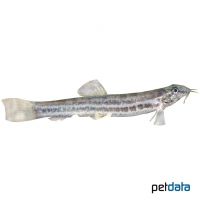Spined Loach (Cobitis taenia)
| Spined Loach Cobitis taenia | |
|---|---|
| Name | Spined Loach |
| Name Lat. | Cobitis taenia |
| Family | Longfin Loaches |
| Family lat. | Cobitidae |
| Order | Carps |
| Order lat. | Cypriniformes |
| Origin | Europe, Asia |
| Habitat | Rivers, lakes |
| Diet | Omnivore |
| pH | 6.5-7.5 |
| Behavior | Nocturnal, peaceful |
| Keeping | Group |
| Care Level | Easy |
| Reproduction | Substrate spawner |
| Breeding | Moderately difficult |
| Life Span | 4-5 years |
| Protection | No |
| Metric Units | |
| Size | 8-10 cm |
| Temperature | 4-18 °C |
| Hardness | 10-15 °dH |
| Aquarium | ~ 200 l or ponds |
| US Units | |
| Size | 3"-4" |
| Temperature | 39-64 °F |
| Hardness | 178-267 ppm |
| Aquarium | ~ 50 gal or ponds |
Distribution and habitat
Rockfish are widely distributed from Europe, where they are absent only in Scotland, Ireland and Scandinavia, to Siberia. They inhabit slow-flowing and stagnant waters with sandy-muddy bottoms. There are several subspecies in their range.
Maintenance
The pond should be furnished with pond, floating and underwater plants (oxygen donors) and a soft bottom substrate of sand suitable for burrowing
When maintaining in a cold water aquarium, care should be taken to provide a large swimming area in addition to dense perimeter planting and numerous hiding places (roots, rocks). A soft, sandy substrate and shaded light (floating plants) is ideal
No ammonia, ammonium and nitrite must be detectable in the water, the nitrate value must not exceed 100 mg/l. To ensure the water quality and oxygen content should not be missing a filter adapted to the water volume.
Diet
They rummage through the bottom for insect larvae, small crustaceans and detritus. The food supply consists of live or frozen cyclops, daphnia, mysis, artemia, mosquito larvae, etc., supplemented with a high-quality sinking dry food (granules, pellets), but this should not be the main component of the diet. In addition, they also need some plant food, such as soft plant material (algae leaves) or dry food with high plant content (e.g. kelp, spirulina). Only feed as much as will be eaten in a few minutes. A regular and varied diet promotes health and increases resistance.
Behaviour and compatibility
They are site-faithful bottom fish that do not show any aggressive or incompatible behavior towards other fish. At least 5, but preferably more rockfish should be kept together. A socialization with other peaceful pond fish is well possible.
In principle, only mutually compatible fish species with similar requirements for water quality and water temperature may be socialized.
Reproduction and breeding
In the slightly smaller and slimmer males, the second pectoral fin ray is thicker than in the females.
The females spawn between April and June. At dusk the females lay their eggs on stones, roots or in the dense undergrowth of aquatic plants. The larvae hatch after about 4-6 days. The young fish grow very slowly. Life expectancy can be up to 5 years.
Important
Rockfish also have intestinal respiration, which allows them to breathe atmospheric air to survive in oxygen-poor waters. Predominantly crepuscular and nocturnal, stonebiters tend to stay buried in the ground or hidden under rocks and roots during the day
If they are overwintered in the pond, sufficient depth and oxygen supply (filter, oxygen dispenser, ice free holder) must be provided.
At temperatures below 8-10 °C the metabolism of the fish slows down and no food is accepted, accordingly feeding must be stopped. If the temperature drops further, they will hibernate buried in the mud. In spring, with rising temperatures, feeding can slowly be resumed. Feeding may also be necessary during prolonged warm periods in winter.
The well-being of the fish should be monitored regularly. A regular partial water change, according to the pond size is recommended, even if the pollutant load has not yet reached the upper limit. Sudden changes in water quality should be avoided. Newly introduced fish must be accustomed slowly to the water in the pond or aquarium
Further literature can be found in your pet store.
References
Text: Werner Winter; Image: petdata
Source: BMELV (1998): Tierschutzgutachten - Haltung von Zierfischen (Süßwasser); RIEHL & BAENSCH (2006): Aquarien Atlas Bd. 1, Mergus Verlag; ENGELMANN (2005): Zootierhaltung - Tiere in menschlicher Obhut: Fische; Harri Deutsch Verlag
- Gemäß § 21 Abs. 5 Tierschutzgesetz idgF
